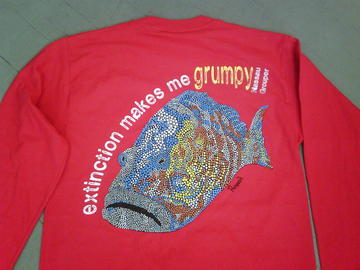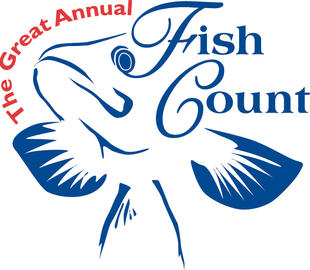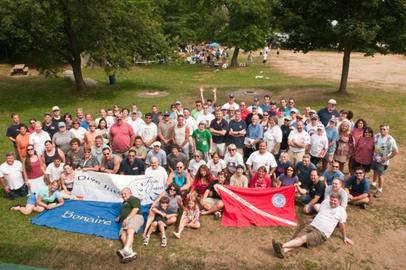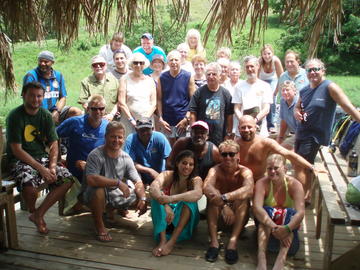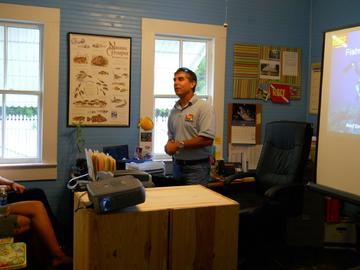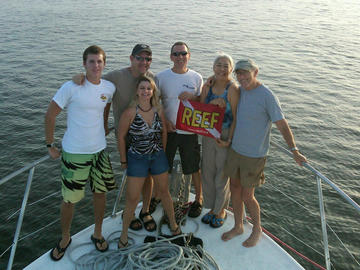On July 17th, Maui celebrated its tenth year as part of the the Great Annual Fish Count (GAFC) with a great event at the Honolua Bay Marine Life Conservation District. As part of the event, several community groups combined to hold a REEF fish count, reef and shoreline clean-up, coral disease survey, and water quality testing. Long-time REEF partners, Donna Brown and Liz Foote, conducted a fish identification class at the Hawaiian Islands Humpback Whale National Marine Sanctuary the week before, and the Sanctuary furnished a van and organized a car pool to travel to the remote location.
Nassau Grouper Shirts Back in the Online Store - After selling out, "Grumpy" shirts are now back in stock in the REEF online store. These short and long-sleeve shirts features the face of a Nassau Grouper. "Grumpy" is the artwork of Rogest, who created the piece to celebrate REEF's Grouper Moon Project and our work to conserve this Caribbean icon. The shirts feature the tag line "Extinction Makes Me Grumpy". Get yours today, they won't last long.
The first Great Annual Fish Count (GAFC) event was held in 1992 at Anacapa Island, California, with fifty participants. Dr. Gary Davis from the Channel Islands National Park came up with the idea as way to engage park visitors. REEF took over the coordination of the event in 1997 when the REEF Fish Survey Project expanded to the US West Coast.
For the ninth year in a row, New England's SCUBA-diving community hosted the largest single-day Great Annual Fish Count (GAFC) event. On July 24, 2010, a stunning 104 divers conducted 114 fish surveys at 13 locations around Cape Ann and southern Maine. After conducting their surveys, divers gathered at Stage Fort Park in Glouster, MA, for fun, food, and prizes (over $8,000 in prizes were donated for the event). The event was coordinated by active REEF volunteers, Holly Martel Bourbon and Bob Michelson, and was sponsored by the New England Aquarium Dive Club.
REEF recently completed a Field Survey trip to Roatan, Honduras, led by REEF co-founder, Paul Humann. Over six days, the group completed 17 survey dives including one night dive. Both novice and highly experienced REEF surveyors enjoyed the near perfect weather and dive conditions. Shortfin pipehorses, wrasse blennies, linesnout gobies, peppermint basslets, orangesided gobies, dash gobies, and blue dartfish are a sample of the cryptic fishes that were observed. Spotted Eagle Rays and Southern Stingrays graced us with their presence on a number of dives.
As the lionfish invasion progresses throughout the Western Atlantic region, marine resource managers are struggling with lionfish control in protected areas. In the Florida Keys National Marine Sanctuary, Sanctuary managers have come up with a special permit process to allow removal of lionfish within the Sanctuary Preservation Areas (no-take zones). A critical part of the permit process is participation in a training and handling workshop conducted by REEF. To date, over 15 workshops have been held in the Keys and over 230 on the water professionals have been trained and permitted.
Greetings REEF Friends!
This month marks the Great Annual Fish Count (GAFC), REEF's annual event that celebrates our fish survey program. In this issue of REEF-in-Brief we highlight a few of the many GAFC events that were held by our partners throughout the month of July. New REEF staff, Alecia Adamson just returned from the Field Survey to Roatan and her report is below. We are also proud to announce that REEF has facilitated the donation of lionfish collection kits to 27 dive operators in the Florida Keys.
In April 2009, REEF started a monthly seminar series to give back to the community that has housed and supported REEF since our inception. REEF Fish & Friends gathers snorkelers, divers, and armchair naturalists at REEF HQ in Key Largo to learn more about fish and have some fun. The July seminar for REEF, Fish & Friends was all about the Great Annual Fish Count (GAFC).
Thirty miles offshore, in 100 feet of water, the Spike isn’t the most accessible dive site off North Florida’s coast but July 17th marked the first anniversary of the former Coast Guard tender’s deployment as an artificial reef so we were eager to see what had changed over the past year. The Spike had only been down 10 days when we surveyed it during last year’s Great Annual Fish Count.


